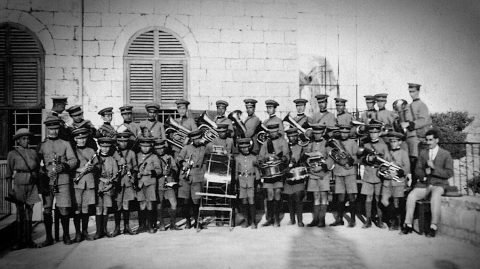When I think of famous musicians of Armenian descent, Cher (born Cherilyn Sarkisian) instantly comes to mind. Or the French-Armenian Charles Aznavour, whose face was inescapable throughout my time in Yerevan, plastered on museums, squares and even on the free T-shirt I got as part of my accreditation. But less spotlight is put on the deeply influential Nerses Nalbandian.
He came to Ethiopia in 1915 following the Armenian genocide, became the band leader of the National Opera and even composed the country’s national anthem, used until the Derg revolution in 1974.
Director Aramazt Kalayjian was inspired to come to Ethiopia after witnessing a single picture. 40 orphaned Armenians who escaped Ottoman devastation and were adopted by Emperor Haile Selassie. Tracing the vast Armenian contribution to Ethio-Jazz and culture through the people and buildings of modern-day Addis Ababa, non-competition entry Tezeta (Aramazt Kalayjian, Garegin Papoyan, 2024) is a lively and fascinating doc about this little-known cultural fusion, deeply rich in history and personal detail.
The title is an untranslatable Amharic (Ethiopian national language) word that can loosely be translated to mean memory, longing or nostalgia. It also lends itself to a form of music that is broadly comparable to the blues. Multiple talking heads, from French musicologist Francis Falceto to the recently departed Alemayehu Eshete — known as “the Ethiopian Elvis” — and director Abate Mekuria, seek to provide a clearer definition throughout this film, which is generous in its varied and, sometimes contradictory, viewpoints.
It’s also generous in its filmmaking techniques — switching between cityscapes and close-ups, professional and raw footage, fly-on-the-wall observation and more staged shots — bearing the full weight of its long ten-year production history.
Traces of Armenian influence can be seen in the St George Orthodox Church or the Taitu Hotel, but rapid modernisation and the hasty erection of skyrise buildings are quickly crowding out the diverse, fascinating influences of this never-colonised town.
The same goes for the people: the official population of Armenians in Ethiopia dwindled after the communist revolution, leaving around 700 people, many of whom were jailed by the authoritarian Derg regime. One of those is Vahé, who is the last Armenian-Ethiopian musician currently performing in the jazz bars and hotels of the capital. We witness him releasing a new album, working with Black musicians, and singing in both Armenian, Amharic and English.
But as a rare white Ethiopian singer, he is constantly under pressure to prove himself, not only as a citizen of this African country but also to Armenians back home — culminating in a powerful homecoming in Vienna, in 2015, representing Ethiopians at Eurovision. It’s a testament to the filmmakers’ dogged ambition, coming to Addis Ababa as early as 2012, and sticking with the subject until they found a suitable catharsis. Let’s hope their next project doesn’t take so long.
Redmond is the editor-in-chief of Journey Into Cinema.
